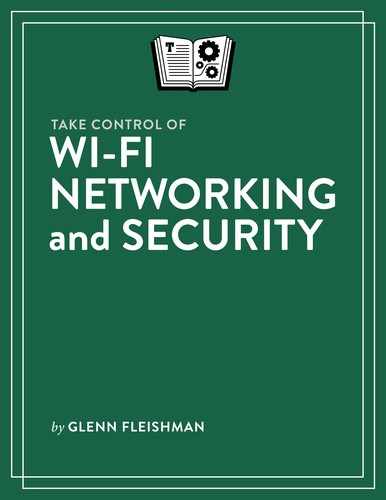Appendix A: What and Where Is a MAC Address?
The MAC, or Media Access Control, address is a unique, factory-assigned address for every Ethernet and Wi-Fi adapter. It has nothing to do with Macintosh computers, despite the unfortunate homograph.
You may need to find a MAC address in a few different cases:
If you or someone else configures an access point so that only specifically identified devices can connect. The MAC address is typically used for identification. (But it’s not secure; see warning below.)
If your network uses reserved DHCP addresses, allowing a gateway or another networked device to always assign a device the same private or public IP address. This often relies on the MAC address.
If you’re trying to determine to which access point a device has connected. Access points use a BSSID (Basic Service Set Identifier), which is effectively the same as a MAC address.
A MAC address consists of six two-digit hexadecimal numbers separated by colons, such as 0C:F2:33:01:02:FC. (Hexadecimal, or hex, is the base 16 number system, with values running from 0 to 9, and then from A to F for 10 to 15.) The first three numbers are assigned to a manufacturer by a coordinating association. MAC addresses may be used for filtering and authentication, often without requiring direct entry.
Here are the ways to locate MAC addresses in various operating systems and on some pieces of hardware.
Find the MAC Address in macOS
Find a Mac’s MAC address like so:
Go to Apple > System Preferences > Network.
Click Wi-Fi in the adapter list
Click the Advanced button in the main window.
In the Wi-Fi view, the MAC number is described as the Wi-Fi Address at the bottom.
Find the MAC Address in iOS or iPadOS
Take a three-step jaunt to locate an iPhone or iPad’s MAC address:
Open Settings.
Tap General > About.
Swipe down to Wi-Fi Address, which is the MAC address.
Find the MAC Address in Windows 10
Windows makes it a little harder, but here’s how to obtain the MAC address:
Click Start.
Select Settings > Network & Internet > Status > Network and Sharing Center.
Next to Connections, select your Wi-Fi network’s name.
In the Wi-Fi Status dialog, click Details.
In the Details window, the MAC address is listed as Physical.
Find the MAC Address in Android
Android nests the MAC address down just a couple of levels, so follow this method:
Open Settings.
Tap Wi-Fi.
Tap the three-vertical-dot button and then Advanced. The MAC Address appears in that view; you may need to swipe down to find it.
Find the MAC Address in ChromeOS
Find the MAC address in ChromeOS with these steps:
Click your account photo.
Click the Wi-Fi icon.
At the top of the box, click Information. The ChromeOS MAC address appears next to Wi-Fi in the resulting window.
Find the MAC Address on Gateways
Every gateway will have a different place in which it lists a device’s MAC address. But all the gateway hardware I’ve tested over the years also has a custom-printed label on the back or bottom that includes the device’s serial number, and MAC and SSID addresses.
You can also open the admin interface for your router and look through the interface. It’s usually found in a status page or quick start page. The TP-Link Archer C7, for instance, puts the wireless LAN, Wi-Fi, and WAN port MAC and BSSID addresses front and center on the first page you seen.
Apple hides the information in its AirPort Utility for macOS, but if you hold down Option when clicking the Edit button, a Summary screen appears that shows all the MAC and BSSID addresses.
